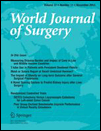Comparison of Peristomal Adhesion Formation Between Laparoscopic and Open Low Anterior Resection of Rectal Cancer
Part of this article was presented at the meeting of The American Society of Colon and Rectal Surgeons, Vancouver, Canada, May 2011.
This is not a randomized controlled study. We selected 97 subjects who were participants in the COREAN (comparison of open versus laparoscopic surgery for mid and low rectal cancer after neoadjuvant chemoradiotherapy) trial, which was published already [ 7].
Abstract
Background
Postoperative adhesions appear to be less common following laparoscopic surgery than after conventional open surgery. The purpose of this study was to compare the impact of laparoscopic and conventional open rectal surgery on peristomal adhesion formation.
Methods
We enrolled 97 subjects who were participants in a trial comparing open versus laparoscopic surgery for mid and low rectal cancer after neoadjuvant chemoradiotherapy. These patients had undergone rectal cancer surgery with ileostomy formation. Peristomal adhesions were assessed during ileostomy takedown using an adhesion grading system: (1) no adhesions or fine, filmy adhesions separable by blunt dissection; (2) dense adhesions, separable by sharp dissection; (3) very dense adhesions, resulting in enterotomy and/or requiring extension of the abdominal wall incision.
Results
A total of 57 patients underwent laparoscopic resection (group A) and 40 underwent open resection (group B). Operating time for ileostomy dissection was shorter in group A than in group B (14.6 vs. 19.8 min, respectively; p = 0.047). Dense adhesions (grades 2 and 3) were more common in group B (22/40, 55 %) than in group A (12/57, 21 %; p < 0.001). In particular, grade 3 adhesions were present only in group B (6/40).
Conclusions
The present findings suggest that laparoscopic rectal surgery results in less peristomal adhesion formation than does conventional open surgery.




